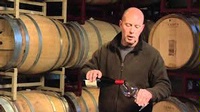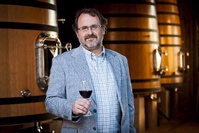|
|
 |
|
June 20, 2013
You could make a case that James MacPhail and Jeff Gaffner are two of
California's most important winemakers. There is an equally strong argument that
no one beyond a tight circle of dedicated wine geeks has ever heard of either.
Yet both men, on parallel paths, are living the dream. Their dream.
MacPhail is the owner/winemaker of MacPhail Family Wines; Gaffner the
owner/winemaker of Saxon Brown Wines. Gaffner launched Saxon Brown in 1997;
MacPhail his winery in 2002.
Early in his career, Gaffner worked under legendary winemaker Dick Arrowood
at Chateau St. Jean; MacPhail spent his formative winemaking years as lieutenant
to iconic winemaker Merry Edwards.
 Both men specialize in small-batch, handcrafted wines that express
characteristics unique to specific vineyard sites situated in the most coveted
winegrowing appellations along the California Coast. Both men specialize in small-batch, handcrafted wines that express
characteristics unique to specific vineyard sites situated in the most coveted
winegrowing appellations along the California Coast.
You may not have heard of either man because their wines are made in
miniscule quantities — hundreds of cases produced instead of thousands — and
sold almost exclusively in wine-savvy restaurants or by wine merchants who prize
individuality.
"I started with enough money to buy fruit and a few barrels," said MacPhail,
remembering the early years operating out of his garage on the edge of the
northern Sonoma village of Healdsburg. "I barely scraped by. But I got some good
press, and my wines turned up in a few of San Francisco's top restaurants just
as pinot noir started to become popular. I caught the wave."
Pinot noir is MacPhail's specialty, though he poured a stunning Gap's Crown
Vineyard Chardonnay and a lovely rose the day we chatted. His arsenal of pinots
is remarkably diverse, expressing the soil, climate and vintage conditions
connected to each vineyard.
"I'm a non-interventionist," he explained. "I guide each wine; I don't
manipulate it."
The common thread throughout all of the MacPhail wines is consistency of
quality and exquisite balance. None of the MacPhail wines will overwhelm the
senses with alcohol or wood. MacPhail also cherishes the earthy nuances of pinot
noir, such as forest floor and mushroom, and strives to bring out those
complexities.
Bottom line, the MacPhail wines don't taste manufactured.
 Gaffner takes a similar approach with a much broader repertoire of
wines. Gaffner could correctly be called a pinot noir specialist (his Black Kite
Pinot Noir from Mendocino's Anderson Valley is some of the finest made in
California), but he is equally adept with cabernet sauvignon, syrah, zinfandel
and his eclectic semillons — Cricket Creek and Bothers Cuvee. Gaffner takes a similar approach with a much broader repertoire of
wines. Gaffner could correctly be called a pinot noir specialist (his Black Kite
Pinot Noir from Mendocino's Anderson Valley is some of the finest made in
California), but he is equally adept with cabernet sauvignon, syrah, zinfandel
and his eclectic semillons — Cricket Creek and Bothers Cuvee.
His wines are notable not only for their quality and distinctiveness, but
also their elegance and finesse. Gaffner has a knack with tannin, producing red
wines that are supple and smooth without sacrificing flavor or resorting to the
use of overripe grapes.
His recently released 2005 Saxon Brown Cabernet Sauvignon is a case in point.
"I call it my anti-Napa Valley cab," he said. "Many winemakers in Napa
over-extract because they think that's what people like, and it grabs the big
scores. Then they leave (residual) sugar in the finished wine to mask the
astringency of the tannin.
"I want something more seductive, more elegant. So for the Saxon Brown
Cabernet, I make it the way a pinot noir guy would make cabernet. I age it three
years in Burgundy barrels, then several years in bottle before we release it. I
made 300 six-packs (150 cases total), and it retails for $75 a bottle. I don't
make a lot of it because it isn't easy."
While Gaffner is critical of a popular Napa Valley winemaking technique, it
should be noted that he also makes a brilliant cabernet-based red Bordeaux-style
blend, Stephanie, for the Hestan family of Napa. While he doesn't barrel down
his Stephanie wines in Burgundy barrels, he does employ the same philosophy with
respect to extraction and astringency.
"I like to get extraction early in the fementation, at lower levels of
alcohol," he said. "The tannins you get at lower alcohol won't take the enamel
off your teeth. When you get enough extraction, you don't need more. I stop. In
California, I believe we need to learn when to stop."
You may not know MacPhail or Gaffner. Perhaps you haven't even tried their
wines. But you've felt their impact nonetheless.
For it is an undeniable fact that more wine enthusiasts are showing support
for wines that exhibit the style and sensibilities you will find in the wines of
James MacPhail and Jeff Gaffner. They are living the dream, and lucky you get to
drink it in.
Posted by Robert Whitley at 6:24 PM
|
|
June 12, 2013
I remember a sidewalk cafe on a warm, humid summer day near the historic hotel Le Cep in Beaune, the spiritual center of France's Burgundy district.
One glance at the wine list and my heart sank — Burgundy as far as the eye could see. Under normal circumstances, the offerings of white Burgundy would have been a welcome sight. But on this occasion, with a bright sun beating down, I longed for a cold, crisp, light white wine. Or a rose. Yes, indeed, wine has its seasons, and we are entering a period that calls for gruner veltliner, sauvignon blanc, rose wines from the south of France or the Central Coast of California; or refreshing prosecco from Northern Italy when in the mood for a bubbly.
Gruner, of course, is the Austrian white that is currently in vogue. It typically exhibits bracing acidity with notes of citrus. Gruner is often consumed with steamed or grilled shellfish, but it's delicious on its own and a refreshing palate-pleaser when served well chilled on a warm day. Pfaffl, from a family estate just outside of Vienna, is first-rate and runs about $20. Perhaps the finest domestic gruner is Zocker, made in California's Edna Valley, also costing about $20.
Sauvignon blanc is grown the world over, though it seems to do best in Bordeaux and the Loire Valley regions of France, New Zealand and coastal California. Pascal Jolivet is a trusted source for Sancerre, and it runs about $25 in most parts of the country. Cloudy Bay is the most renowned of all the New Zealand sauvignons, but you will pay upward of $30 when you can find it. For value, few California sauvignons can outshine the Dry Creek Vineyard Fume Blanc at about $14.
Rose wines are difficult to recommend because production of the top wines is generally limited. I enjoy the hunt and am always on the lookout for a good rose. The Eberle winery in Paso Robles produces a delicious rose made from syrah grapes, and it costs $16. If you have a generous budget, then try Domaines Ott from the Provence region in the south of France. It should be in the $40 range.
Prosecco is perfect for summer sipping because it's lighter than Champagne and most domestic bubbly, and generally less expensive. My favorites are Adami and Bisol, each a producer well regarded for exceptional quality. You should be able to source either one for $20 or less.
Posted by Robert Whitley at 10:32 AM
|
|
 |
|